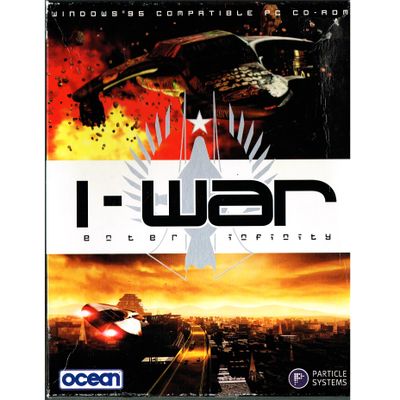I-WAR PC BIGBOX
Beskrivning av I-WAR PC BIGBOX
I-WAR PC BIGBOX
I-War (known as Independence War in North America) is a space combat simulator developed by Particle Systems. The game was first published in 1997 in Europe by Infogrames, and in late August of 1998 in North America. An additional campaign was designed, packaged with the original game and released in 1999 as Independence War Deluxe Edition in North America and Independence War Special Edition in Europe.
The sequel Independence War 2: Edge of Chaos was released in 2001.
As the captain of Dreadnaught, the player could assume the command of any of the four workstations on the command bridge. From the command station (CMD), the player received his/her mission briefings and could sometimes control other ships through a remote link. The station also had access to an accurate star map. The ship was normally flown from the navigation station (NAV). From the weapons station (WEP), the player had an outside view of Dreadnaught's wire frame model. Following a locked target, the angle of view could rotate 360 degrees on all axes. This workstation also had a ripple fire mode which allowed attacking quickly a large group of enemies. The fourth station engineering (ENG) was for controlling the repairs when the ship was damaged by weapons or a collision with another object. However, the automated repair functioned well and player supervision was rarely needed. The station also had a fuel gauge, which was nonfunctional because the game design was changed to give Dreadnaught limitless fuel.
In the game, the player takes the role of an unnamed 23rd century spaceship captain in the Earth Commonwealth Navy. The primary opponents were rebellious insurgents called the Indies, a group distinguished by their elaborately and colourfully painted ships.
I-War was notable for its use of Newtonian physics; unlike other popular space combat games such as Wing Commander and Descent: Freespace, the flight model is subject to inertia caused by a ship's mass and the absence of drag in outer space. In addition to common flight dynamics, vessels can move and accelerate in all directions: up, down, forward, backwards and sideways.
The game features two gameplay modes: campaign mode, and a mode for immediate space battle with endlessly spawning enemies. The campaign consists of a series of 40 linear missions, with one or more missions being available at a time. After completing a key mission, one or more new missions become available. Sometimes a different set of missions can be unlocked depending of the outcome of the previous mission, thus setting the campaign in different directions. Three different endings to the campaign were possible. The nature of missions varied greatly; there were many combinations of combat and problem solving. The puzzles often made use of the game's physics modeling.
Depending on the mission, Dreadnaught can be acting alone, supporting another vessel, or commanding a group of wingmen. During other missions, various special equipment is at the player's disposal, such as a reconnaissance drone.
The player ship is armed with Particle Beam cannons and various kinds of missiles. For protection, the ship is equipped with energy shields, that are capable of tracking and absorbing enemy fire from a single ship at a time. The bridge of the player ship is a small ship of its own, called the 'command section'. It is capable of detaching from the rest of the ship.
During LDS-travel, ships are not able to use any weapons except missiles designed to stop LDS-travel. Ships in LDS cannot be attacked, either.
KOMPLETT I BOX




